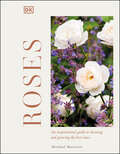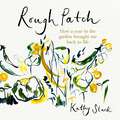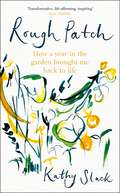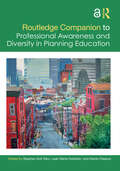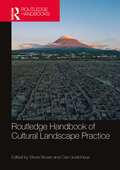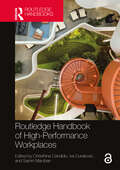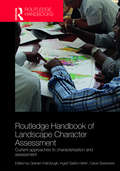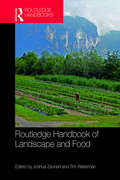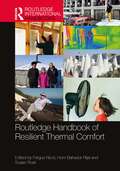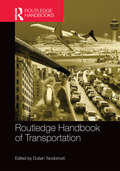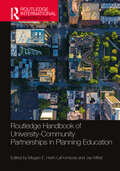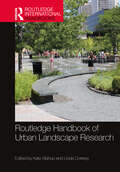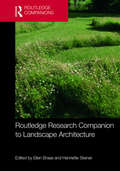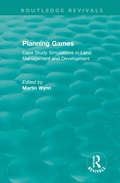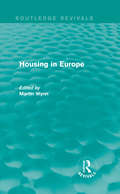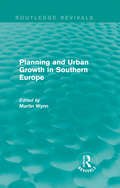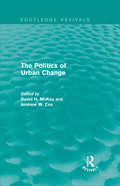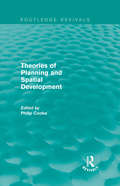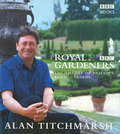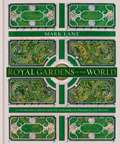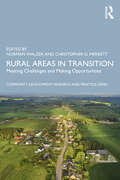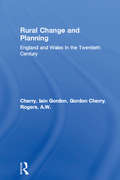- Table View
- List View
Roses: An Inspirational Guide to Choosing and Growing the Best Roses
by Michael V MarriottCelebrating the very best of roses, including the right varieties to choose and how to grow them. With more than 30,000 different types of roses available to gardeners across the world, how do you find the right one for your garden? A rose is one of the most beautiful, versatile, and rewarding plants that a gardener can grow. Roses is a joyous celebration of this garden icon that brings together stunning photography of rose gardens and displays from across the world with practical, expert advice on how to choose, grow, and enjoy roses in any garden, anywhere. Far more than a basic guide to rose cultivation, this invaluable guide teaches gardeners how they can make the most of their garden&’s unique qualities, from practical considerations like soil and climate to the mood and style of the space. With the book&’s unique &“rose selector&” section, readers can identify the ideal roses for their garden and discover the varieties best suited to uses such as for scent or for pergolas.
Rough Patch: How a Year in the Garden Brought Me Back to Life
by Kathy SlackWhen Kathy was forced to quit her high-flying career in London, she was a wreck - burnt out, anxious, consumed by depression. But she found solace in an unlikely place - the veg patch. She put her hands in the soil and found a way to grow, to sow some small seeds of hope.In Rough Patch, Kathy draws us into the world of the kitchen garden to reflect on the lessons she learnt from the soil, along with sharing recipes inspired by the land. Weaving together her own story of recovery with the year she spent growing and cooking her harvests, Kathy realises that the two are tightly bound together and that reconnecting with the earth could restore her hope and renew her life. Along the way there are tales of marauding pigs, transformative insights from planting leeks, recipes for an unchecked courgette glut and the discovery of why a radish seed is worth staying alive for. The result is a candid, hopeful and sometimes funny story about the healing powers of nature; a quiet manifesto for a more connected life.PLEASE NOTE: When you purchase this title, the accompanying PDF will be available in your Audible Library along with the audio
Rough Patch: How a Year in the Garden Brought Me Back to Life
by Kathy SlackWhen Kathy was forced to quit her high-flying career in London, she was a wreck - burnt out, anxious, consumed by depression. But she found solace in an unlikely place - the veg patch. She put her hands in the soil and found a way to grow, to sow some small seeds of hope.In Rough Patch, Kathy draws us into the world of the kitchen garden to reflect on the lessons she learnt from the soil, along with sharing recipes inspired by the land. Weaving together her own story of recovery with the year she spent growing and cooking her harvests, Kathy realises that the two are tightly bound together and that reconnecting with the earth could restore her hope and renew her life. Along the way there are tales of marauding pigs, transformative insights from planting leeks, recipes for an unchecked courgette glut and the discovery of why a radish seed is worth staying alive for. The result is a candid, hopeful and sometimes funny story about the healing powers of nature; a quiet manifesto for a more connected life.
Round Loom Knitting Patterns
by Nicole ClarkThis book offers an introduction to "rake" or loom knitting. This technique is easy to learn and is explained in detail in the book. Patterns include, dish cloths, hats, socks, stockings, baby booties, and more. From the book jacket: Knitting loom patterns and variations for: - Afghans - Baby Booties - Chrismas Stockings Hats - Scarves - Socks - Sweaters Over 50 Pictures and Illustrations. "This is the funnest pattern book of its type. The author makes it fun to do knitting on round looms." - Mary Allen, Houston, TX "Every pattern is easy to read and understand." - Jan Wirthlin, Dover, OH "My kids were ready to move on to making more complicated patterns, and this book helped me show them how." - Margaret Brown, Highmore, SD
Routledge Companion to Professional Awareness and Diversity in Planning Education
by Danilo Palazzo Stephen Kofi Diko Leah Marie HollsteinThe Routledge Companion to Professional Awareness and Diversity in Planning Education engenders a discourse on how urban planning as a discipline is being made attractive to children and youth as they consider their career preferences. It also provides a discourse around the diversity challenges facing the institutions for training urban planning professionals. This Companion is an impressive collection of initiatives, experiences, and lessons in helping children, youth, and the general public appreciate the importance of, and the diversity challenge confronting, the urban planning profession and education. It comprises empirical, experimental, and case study research on initiatives to address the professional awareness and diversity challenges in urban planning. It has uniquely assembled voices and experiences from countries in Africa, Asia, Europe, and North America. Contributors are educators, practitioners, and activists of urban planning as well as policymakers in their respective countries. This Companion is intended as a resource for urban planning schools and departments, foundations, non-profit organizations, private sector organizations, public institutions, teachers, and alumni, among others to learn and consciously drive efforts to increase planning education awareness among children, youth, and the general public.
Routledge Companion to Professional Awareness and Diversity in Planning Education
by Danilo Palazzo Stephen Kofi Diko Leah Marie HollsteinThe Routledge Companion to Professional Awareness and Diversity in Planning Education engenders a discourse on how urban planning as a discipline is being made attractive to children and youth as they consider their career preferences. It also provides a discourse around the diversity challenges facing the institutions for training urban planning professionals.This Companion is an impressive collection of initiatives, experiences, and lessons in helping children, youth, and the general public appreciate the importance of, and the diversity challenge confronting, the urban planning profession and education. It comprises empirical, experimental, and case study research on initiatives to address the professional awareness and diversity challenges in urban planning. It has uniquely assembled voices and experiences from countries in Africa, Asia, Europe, and North America. Contributors are educators, practitioners, and activists of urban planning as well as policymakers in their respective countries.This Companion is intended as a resource for urban planning schools and departments, foundations, non-profit organizations, private sector organizations, public institutions, teachers, and alumni, among others to learn and consciously drive efforts to increase planning education awareness among children, youth, and the general public.Chapter 6 of this book is freely available as a downloadable Open Access PDF at http://www.taylorfrancis.com under a Creative Commons Attribution-Non Commercial-No Derivatives (CC-BY-NC-ND) 4.0 license.
Routledge Handbook of Cultural Landscape Practice (Routledge International Handbooks)
by Steve Brown Cari GoetcheusCultural landscapes, which in the field of heritage studies and practice relates to caring for and safeguarding heritage landscapes, is a concept embedded in contemporary conservation. Heritage conservation has shifted from an historical focus on buildings, city centres, and archaeological sites to encompass progressively more diverse forms of heritage and increasingly larger geographic areas, embracing both rural and urban landscapes. While the origin of the idea of cultural landscapes can be traced to the late-19th century Euro-American scholarship, it came to global attention after 1992 following its adoption as a category of ‘site’ by the UNESCO World Heritage Committee. Today, cultural landscape practice has become increasingly complex given the expansion of the values and meanings of heritage, the influence of environmental challenges such as human induced climate change, technological advancements, and the need to better understand and interpret human connections to place and landscapes. The aim of this handbook is to strike a balance between theory and practice, which we see as inseparable, while also seeking to achieve a geographical spread, disciplinary diversity and perspectives, and a mix of authors from academic, practitioner, management, and community backgrounds.
Routledge Handbook of High-Performance Workplaces (Transdisciplinary Workplace Research and Management)
by Christhina Candido Iva Durakovic Samin MarzbanThis timely book focuses on an overview of the fundamentals behind high-performance workplaces underpinning occupants’ satisfaction, health, and productivity. To this end, it covers human, environmental, and organisational aspects proven to be of great relevance to the design of high-performance workplaces. Perhaps most significantly it looks at these characteristics both before and after the start of the COVID-19 pandemic. From the exodus from private offices to the rise of open-plan workplaces, where, how and when people work was changing rapidly pre-COVID. Post-COVID, pandemic-imposed restrictions banished workers from offices into their homes fast, leaving organisation scrambling to keep workers functioning away from HQ. After the immediate shockwaves set by the pandemic, workers and organisations have had the time to learn about positives and negative aspects of remote working with the vast majority now questioning the need to go back to HQ and the purpose of offices. In this book, the contributors share and discuss lessons learned from research conducted in workplaces pre- and post-2020 with a view of providing a clear picture about what high-performance workplaces are about, including the key drivers behind workers’ satisfaction, health, and productivity. This handbook builds on a programme of applied research conducted in workplaces led by the editors over the last decade which is aimed at understanding the synergies between the design, performance, and experience of spaces. It examines ergonomics, biophilic design, acoustics, indoor air quality, thermal comfort, diversity, leadership, psychological safety, culture, and much more. Research findings are presented side-by-side with case studies selected from the research database led by the editors. Industry experts add to the academic voice, reinforcing the authenticity of this book and its relevance to other stakeholders found outside the academic arena, including the property and design industry, students, government, and the community in general.The Open Access version of this book, available at http://www.taylorfrancis.com, has been made available under a Creative Commons Attribution-Non Commercial-No Derivatives (CC-BY-NC-ND) 4.0 license.
Routledge Handbook of Landscape Character Assessment: Current Approaches to Characterisation and Assessment
by Graham Fairclough Ingrid Sarlöv Herlin Carys SwanwickIn this multi-authored book, senior practitioners and researchers offer an international overview of landscape character approaches for those working in research, policy and practice relating to landscape. Over the last three decades, European practice in landscape has moved from a narrow, if relatively straightforward, focus on natural beauty or scenery to a much broader concept of landscape character constructed through human perception, and transcending any of its individual elements. Methods, tools and techniques have been developed to give practical meaning to this idea of landscape character. The two main methods, Landscape Character Assessment (LCA) and Historic Landscape Characterisation (HLC) were applied first in the United Kingdom, but other methods are in use elsewhere in Europe, and beyond, to achieve similar ends. This book explores why different approaches exist, the extent to which disciplinary or cultural specificities in different countries affect approaches to land management and landscape planning, and highlights areas for reciprocal learning and knowledge transfer. Contributors to the book focus on examples of European countries – such as Sweden, Turkey and Portugal – that have adopted and extended UK-style landscape characterisation, but also on countries with their own distinctive approaches that have developed from different conceptual roots, as in Germany, France and the Netherlands. The collection is completed by chapters looking at landscape approaches based on non-European concepts of landscape in North America, Australia and New Zealand. This book has an introductory price of £125/$205 which will last until 3 months after publication - after this time it will revert to £140/$225.
Routledge Handbook of Landscape and Food
by Tim Waterman Joshua ZeunertSince the turn of the millennium, there has been a burgeoning interest in, and literature of, both landscape studies and food studies. Landscape describes places as relationships and processes. Landscapes create people’s identities and guide their actions and their preferences, while at the same time are shaped by the actions and forces of people. Food, as currency, medium, and sustenance, is a fundamental part of those landscape relationships. This volume brings together over fifty contributors from around the world in forty profoundly interdisciplinary chapters. Chapter authors represent an astonishing range of disciplines, from agronomy, anthropology, archaeology, conservation, countryside management, cultural studies, ecology, ethics, geography, heritage studies, landscape architecture, landscape management and planning, literature, urban design and architecture. Both food studies and landscape studies defy comprehension from the perspective of a single discipline, and thus such a range is both necessary and enriching. The Routledge Handbook of Landscape and Food is intended as a first port of call for scholars and researchers seeking to undertake new work at the many intersections of landscape and food. Each chapter provides an authoritative overview, a broad range of pertinent readings and references, and seeks to identify areas where new research is needed—though these may also be identified in the many fertile areas in which subjects and chapters overlap within the book.
Routledge Handbook of Resilient Thermal Comfort (Routledge International Handbooks)
by Fergus NicolThis book brings together some of the finest academics in the field to address important questions around the way in which people experience their physical environments, including temperature, light, air-quality, acoustics and so forth. It is of importance not only to the comfort people feel indoors, but also the success of any building as an environment for its stated purpose. The way in which comfort is produced and perceived has a profound effect on the energy use of a building and its resilience to the increasing dangers posed by extreme weather events, and power outages caused by climate change. Research on thermal comfort is particularly important not only for the health and well-being of occupants but because energy used for temperature control is responsible for a large part of the total energy budget of the built environment. In recent years there has been an increasing focus on the vulnerabilities of the thermal comfort system; how and why are buildings failing to provide safe and agreeable thermal environments at an affordable price? Achieving comfort in buildings is a complex subject that involves physics, behaviour, physiology, energy conservation, climate change, and of course architecture and urban design. Bringing together the related disciplines in one volume lays strong, multi-disciplinary foundations for new research and design directions for resilient 21st century architecture. This book heralds workable solutions and emerging directions for key fields in building the resilience of households, organisations and populations in a heating world.
Routledge Handbook of Transportation
by Dušan TeodorovićThe Routledge Handbook of Transportation offers a current and comprehensive survey of transportation planning and engineering research. It provides a step-by-step introduction to research related to traffic engineering and control, transportation planning, and performance measurement and evaluation of transportation alternatives. The Handbook of Transportation demonstrates models and methods for predicting travel and freight demand, planning future transportation networks, and developing traffic control systems. Readers will learn how to use various engineering concepts and approaches to make future transportation safer, more efficient, and more sustainable. Edited by Dušan Teodorović and featuring 29 chapters from more than 50 leading global experts, with more than 200 illustrations, the Routledge Handbook of Transportation is designed as an invaluable resource for professionals and students in transportation planning and engineering.
Routledge Handbook of University-Community Partnerships in Planning Education (Routledge International Handbooks)
by Heim LaFrombois, Megan E. Jay MittalThis handbook explores two guiding questions – how can university-community partnerships in planning education work, and how can they be transformative? University-community partnerships – often referred to as service-learning or community-engaged teaching and learning – are traditionally based on a collaborative relationship between an academic partner and a community-based partner, in which students from the academic partner work within the community on a project. Transformational approaches to university-community partnerships are approaches that develop and sustain mutually beneficial collaborations where knowledge is co-created and new ways of knowing and doing are discovered. This edited volume examines a variety of university-community partnerships in planning education, from a number of different perspectives, with a focus on transformative models. The authors explore broader theoretical issues, including topics relating to pedagogy, planning theory, and curriculum; along with more practical topics relating to best practices, logistics, institutional support, outcome measures, and the various forms these partnerships can take – all through an array of case studies. The authors, which include academics, professional practitioners, academic practitioners, and students, bring an incredible depth and breadth of knowledge and experience from across the globe – Australia, Canada, Chile, Europe (including Germany, Spain, Slovakia, and Sweden), India, Jamaica, South Korea, and the United States.
Routledge Handbook of Urban Landscape Research (Routledge International Handbooks)
by Kate Bishop Linda CorkeryLandscape architecture is one of the key professions dedicated to making cities hospitable and healthy places to live, work and play, while respecting and enhancing the natural environments and landscapes we inhabit. This edited collection presents current writing about the pivotal roles that landscape architects play in addressing some of the most pressing problems facing the planet, its environments and its populations through their research, analysis and speculative practice. The book has assembled current writings on recent research structured around five major themes: governance, power and partnership; infrastructure, systems and performance; environment, resilience and climate change; people, place and design; and culture, heritage and identity. As a collection, the chapters demonstrate the diversity of themes and topics that are expanding the scholarly body of knowledge for the discipline and its relevance to the practice of landscape architecture. The contributors to this book are academic researchers and practitioners from the discipline of landscape architecture. The chapters draw on their research, teaching and experience as well as analysis of project examples. Fifty-two contributors from the United Stsates, United Kingdom, Sweden, Denmark, the Netherlands, Nigeria, Malaysia, Spain, Colombia, Australia, New Zealand and Canada discuss a diverse range of contemporary themes in urban landscape architecture. Collectively, the contributors demonstrate the breadth of experience, shared concerns and distinct issues that challenge urban landscape architecture and cities in the 21st century.
Routledge Research Companion to Landscape Architecture
by Ellen Braae Henriette SteinerThe Routledge Research Companion to Landscape Architecture considers landscape architecture’s increasingly important cultural, aesthetic, and ecological role. The volume reflects topical concerns in theoretical, historical, philosophical, and practice-related research in landscape architecture – research that reflects our relationship with what has traditionally been called ‘nature’. It does so at a time when questions about the use of global resources and understanding the links between human and non-human worlds are more crucial than ever. The twenty-five chapters of this edited collection bring together significant positions in current landscape architecture research under five broad themes – History, Sites and Heritage, City and Nature, Ethics and Sustainability, Knowledge and Practice – supplemented with a discussion of landscape architecture education. Prominent as well as up-and-coming contributors from landscape architecture and adjacent fields including Tom Avermaete, Peter Carl, Gareth Doherty, Ottmar Ette, Matthew Gandy, Christophe Girot, Anne Whiston Spirn, Ian H. Thompson and Jane Wolff seek to widen, fuel, and frame critical discussion in this growing area. A significant contribution to landscape architecture research, this book will be beneficial not only to students and academics in landscape architecture, but also to scholars in related fields such as history, architecture, and social studies.
Routledge Revivals: Case Study Simulations in Land Management and Development (Routledge Revivals)
by Martin WynnFirst published in 1985, this book presents seven games for use in the teaching and study of planning, urban studies or land administration. These simulations are all built on researched case studies and deal with a number of critical planning and developmental issues; for each one the book provides full operational instructions and all gaming materials required. The games in this volume cover a number of scenarios, including the design of a mixed retail, social and service centre in a new city, new development in a run-down inner city area, rehabilitation or renewal of housing, tourist development in the Mediterranean and a new cross-town motorway in a major north American city. In addition, sets of guidelines for those wishing to design and operate their own case study simulations are also included. This book will be a valuable resource for students of town planning or urban development who are keen to gain ‘hands-on’ experience of using the professional skills they have acquired on their courses.
Routledge Revivals: Housing In Europe (1984) (Routledge Revivals)
by Martin WynnFirst published in 1984, this book presents a survey of housing problems in various European countries and how individual states have responded. Each chapter begins by surveying the problem in each country since the Second World War, before going on to outline the roles fulfilled by national housing agencies and local authorities, as well as assessing the impact of housing policies on society and on the physical shape of cities. It considers whether housing policies have succeeded or failed and how the ‘housing problem’ has changed over time. Each chapter draws out lessons that can be learned for the future from each country’s past handling of the problem. This book will be a useful reference for those interested in housing, including planners, geographers, economists, sociologists or policy-makers.
Routledge Revivals: Planning And Urban Growth In Southern Europe (1984) (Routledge Revivals)
by Martin WynnFirst published in 1984, this book addresses key questions about the pattern of urban development in Southern Europe and the mechanisms employed to control and regulate this development in individual countries. It examines five countries – Greece, Italy, Portugal, Spain and Turkey – that have experienced different scales and rates of urbanization and industrialization. It identifies common problems arising from these processes, as well as the successes and failures of the planning policies employed to regulate development. This book will be of great value to geographers interested in Southern Europe and urban and regional planners interested in comparative patterns of development.
Routledge Revivals: The Politics of Urban Change (1979)
by David H. McKay Andrew W. CoxFirst published in 1979, this book examines key planning policy areas such as land use planning, land values, housing and slum clearance, urban transport, industrial and regional economic location policies, and policies inner city policies to explain why particular policies have been adopted at particular times — assessing the role of political parties, bureaucrats and interests in setting the national policy agenda. Policy is also placed in the broader economic and social context and the question of whether, given contemporaneous constraints, a coherent national urban policy is possible is examined. Its focus on political parties’ role in urban change at the start of Thatcher-era upheavals makes this book especially valuable to students of urban sociology and the history of planning.
Routledge Revivals: Theories of Planning and Spatial Development (Routledge Revivals)
by Philip CookeFirst published in 1983, this book attempts to unify two bodies of theory which had become severely disjointed. Theories of the planning process had become detached from those of the urban and regional processes which are the subject of planning intervention. The author argues that major weaknesses of planning intervention in cities and regions have resulted from this split, and shows how it is possible to develop an integrated theory of the relationship between planning and spatial development. The mechanism which helps to unify the two fields is the division of labour. This poses problems for the planning system as its spatial requirements change but it depends upon the state planning framework in order to overcome those obstacles — hindering its capacity for spatial reorganisation. This book offers a thorough analysis of these obstacles and requirements by references to contemporaneous theoretical advances in the study of the development process, the state (especially at sub-national level), and the labour market. It is argued that the way capital makes use of urban and regional space can be explained by using the theoretical framework which is developed and, on this basis, point to certain innovative ways in which the processes underlying urban and regional de-industrialisation may be countered.
Royal Gardeners
by Alan TitchmarshAlan Titchmarsh takes us on a fascinating tour through the history of Britains royal gardens from medieval times to the present day. Taking in existing royal gardens as well as many that now only exist in paintings, Alan uncovers the stories behind the gardens and the colourful monarchs who created them. From Hampton Court Palace to Kew Palace and Gardens, to Osborne House and through to the modern day developments at the Prince of Wales' home at Highgrove, Alan takes a highly personal canter through Britains gardening heritage. Fully illustrated with original plans, designs, letters, planting records and full colour diagrams of the major surviving gardens, this is a sumptuous book charting some of the most outstanding gardens in Britain.
Royal Gardens of the World: 21 Celebrated Gardens from the Alhambra to Highgrove and Beyond
by Mark LaneThe book is a sumptuous exploration of 21 of the world's most celebrated royal gardens, from the formal splendour of Versailles to the organic, sustainable Highgrove.In mainland Europe you can journey from the formal splendour of Het Loo in the Netherlands and Fontainebleau in France to the Baroque World Heritage Site of the Royal Palace of Caserta in Southern Italy. Further afield still lies the Taj Mahal in India and the Peterhof Palace in Russia.Each featured garden will include the history, plantings and evolution of the garden as well as plant portraits of key plants and information about the design and layout of each. Countries included are: England, Scotland, Germany, France, Italy, Spain, Austria, the Czech Republic, the Netherlands, Sweden, Denmark, Russia, India, Bali and Japan.This inspiring global selection of royal gardens is a perfect gift for any gardening enthusiast or armchair traveller and takes the reader on a journey of architecturally significant houses and their classic gardens as well as providing planting ideas that range from modest to grand, simple to ornate.
Royal Gardens of the World: 21 Celebrated Gardens from the Alhambra to Highgrove and Beyond
by Mark LaneThe book is a sumptuous exploration of 21 of the world's most celebrated royal gardens, from the formal splendour of Versailles to the organic, sustainable Highgrove.In mainland Europe you can journey from the formal splendour of Het Loo in the Netherlands and Fontainebleau in France to the Baroque World Heritage Site of the Royal Palace of Caserta in Southern Italy. Further afield still lies the Taj Mahal in India and the Peterhof Palace in Russia.Each featured garden will include the history, plantings and evolution of the garden as well as plant portraits of key plants and information about the design and layout of each. Countries included are: England, Scotland, Germany, France, Italy, Spain, Austria, the Czech Republic, the Netherlands, Sweden, Denmark, Russia, India, Bali and Japan.This inspiring global selection of royal gardens is a perfect gift for any gardening enthusiast or armchair traveller and takes the reader on a journey of architecturally significant houses and their classic gardens as well as providing planting ideas that range from modest to grand, simple to ornate.
Rural Areas in Transition: Meeting Challenges & Making Opportunities (Community Development Research and Practice Series)
by Norman Walzer Christopher D. MerrettThis volume explores new opportunities to reshape local economies in rural areas during the next decade by exploring successful efforts already underway. While reported population declines can paint a bleak picture for rural areas, a different story can be told in looking at the numbers of households, employment, and housing markets. In fact, many rural areas have had steady employment and healthy housing markets. Rural attractions often include proximity to natural recreation areas, personal safety, social interaction, less expensive housing, and high-quality education. This book shows that rural areas are in a major long-term transition and that local leaders who take advantage of these opportunities in their community and economic development strategies can create a very positive future for residents. Students and policymakers in local economic development, sociology of population change, business finance, political economy, and geography will find this a useful resource.
Rural Change and Planning: England and Wales in the Twentieth Century (Planning, History and Environment Series)
by Gordon Cherry A.W. RogersThis book provides a critical overview of rural change over the eighty years since the outbreak of the Great War, making clear the historical origins of present-day policy. It also provides a structural integration for the many diverse themes which must be interwoven in order to understand current conditions in the countryside.
